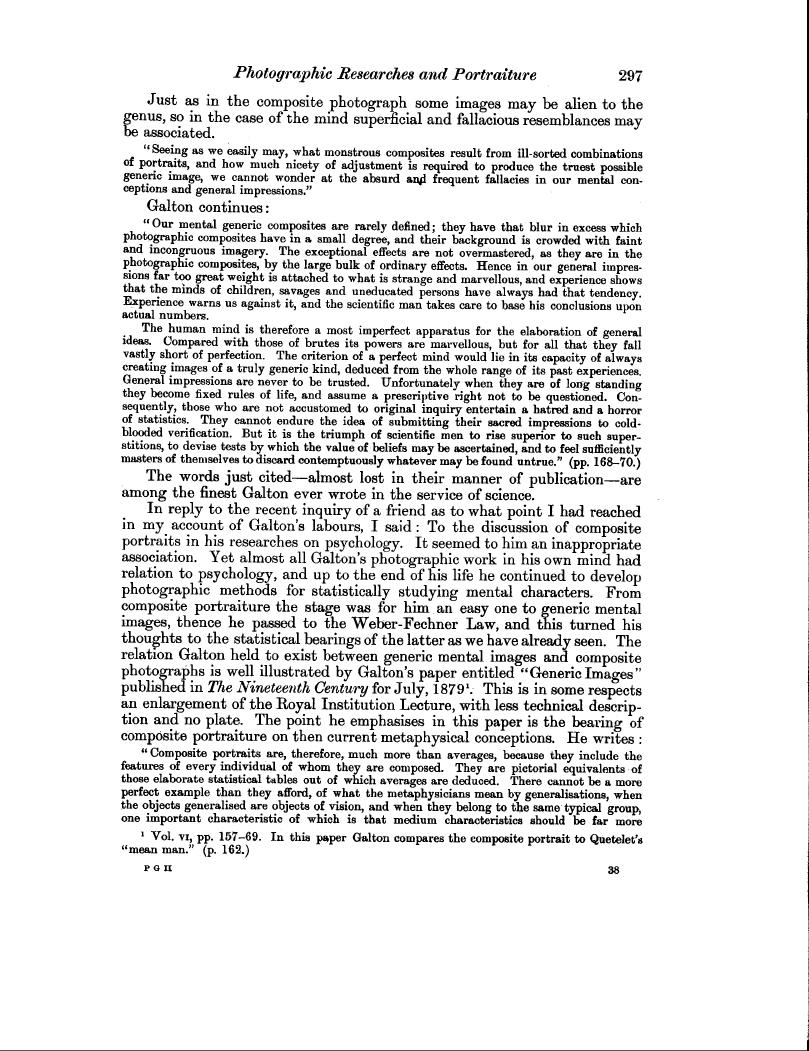gPhotographic Researches and Portraiture 297 Just as in the composite photograph some images may be alien to the enus, so in the case of the mind superficial and fallacious resemblances may
associated.
"Seeing as we easily may, what monstrous composites result from ill-sorted combinations of portraits, and how much nicety of adjustment is required to produce the truest possible generic image, we cannot wonder at the absurd an4l frequent fallacies in our mental conceptions and general impressions."
Galton continues
"Our mental generic composites are rarely defined; they have that blur in excess which photographic composites have in a small degree, and their background is crowded with faint and incongruous imagery. The exceptional effects are not overmastered, as they are in the photographic composites, by the large bulk of ordinary effects. Hence in our general impressions far too great weight is attached to what is strange and marvellous, and experience shows that the minds of children, savages and uneducated persons have always had that tendency. Experience warns us against it, and the scientific man takes care to base his conclusions upon actual numbers.
The human mind is therefore a most imperfect apparatus for the elaboration of general ideas. Compared with those of brutes its powers are marvellous, but for all that they fall vastly short of perfection. The criterion of a perfect mind would lie in its capacity of always creating images of a truly generic kind, deduced from the whole range of its past experiences. General impressions are never to be trusted. Unfortunately when they are of long standing they become fixed rules of life, and assume a prescriptive right not to be questioned. Consequently, those who are not accustomed to original inquiry entertain a hatred and a horror of statistics. They cannot endure the idea of submitting their sacred impressions to coldblooded verification. But it is the triumph of scientific men to rise superior to such superstitions, to devise tests by which the value of beliefs may be ascertained, and to feel sufficiently masters of themselves to discard contemptuously whatever may be found untrue." (pp. 168-70.)
The words just cited-almost lost in their manner of publication-are among the finest Galton ever wrote in the service of science.
In reply to the recent inquiry of a friend as to what point I had reached in my account of Galton's labours, I said : To the discussion of composite portraits in his researches on psychology. It seemed to him an inappropriate association. Yet almost all Galton's photographic work in his own mind had relation to psychology, and up to the end of his life he continued to develop photographic methods for statistically studying mental characters. From composite portraiture the stage was for him an easy one to generic mental images, thence he passed to the Weber-Fechner Law, and this turned his thoughts to the statistical bearings of the latter as we have alread seen. The relation Galton held to exist between generic mental images and composite photographs is well illustrated by Galton's paper entitled "Generic Images" published in The Nineteenth Century for July, 18791.- This is in some respects an enlargement of the Royal Institution Lecture, with less technical description and no plate. The point he emphasises in this paper is the bearing of composite portraiture on then current metaphysical conceptions. He writes
"Composite portraits are, therefore, much more than averages, because they include the features of every individual of whom they are composed. They are pictorial equivalents of those elaborate statistical tables out of which averages are deduced. There cannot be a more perfect example than they afford, of what the metaphysicians mean by generalisations, when the objects generalised are objects of vision, and when they belong to the same typical group, one important characteristic of which is that medium characteristics should be far more
1 Vol. vi, pp. 157-69. In this paper Galton compares the composite portrait to Quetelet's "mean man." (p. 162.)
Poil 38

